Chemometric and Physico-Chemical Characterization of Fruit and Olive Oils from Autochthonous Cultivars Grown in Aragon (Spain)
Abstract
:1. Introduction
2. Materials and Methods
2.1. Experimental Design
2.1.1. Pedoclimatic Characteristics of the Study Area
2.1.2. Olive Samples
2.2. Olive Fruit Analyses
2.3. Olive Oil Extraction
2.4. Olive Oil Analyses
2.4.1. Physico-Chemical Quality Parameters
2.4.2. Fatty Acid Composition
2.4.3. Sterols and Triterpene Dialcohols Composition
2.4.4. Total Phenol Content
2.4.5. Oxidative Stability
2.5. Statistical Analysis
3. Results and Discussion
3.1. Olive Fruit Parameters
3.2. Quality Parameters
3.3. Fatty Acids Composition
3.4. Polyphenols and Oxidative Stability
3.5. Minor Unsaponifiable Compounds: Sterols and Triterpenic Dialcohols
3.6. Chemometric Analysis
4. Conclusions
Author Contributions
Funding
Institutional Review Board Statement
Informed Consent Statement
Data Availability Statement
Acknowledgments
Conflicts of Interest
References
- Dag, C.; Demirtas, I.; Ozdemir, I.; Bekiroglu, S.; Ertas, E. Biochemical characterization of Turkish extra virgin olive oils from six different olive varieties of identical growing conditions. J. Am. Oil Chem. Soc. 2015, 92, 1349–1356. [Google Scholar] [CrossRef]
- Inglese, P.; Famiani, F.; Galvano, F.; Servili, M.; Esposto, S.; Urbani, S. Factors Affecting Extra-Virgin Olive Oil Composition. Hortic. Rev. (Am. Soc. Hortic. Sci.) 2011, 38, 83–147. [Google Scholar]
- International Olive Council (IOC). Available online: https://www.internationaloliveoil.org/what-we-do/economic-affairs-promotion-unit/ (accessed on 1 June 2022).
- Statistical Yearbook of Ministry of Agriculture, Fisheries and Food, Spanish Government. Available online: https://www.mapa.gob.es/es/estadistica/temas/publicaciones/anuario-de-estadistica/ (accessed on 1 June 2022).
- Espada, J.L.; Gracia, M.S. Variedades de Olivo Cultivadas en el Somontano de Barbastro y Características de Sus Aceites; Gobierno de Aragón: Zaragoza, Spain, 2009. [Google Scholar]
- Viñuales, J. Variedades de Olivo del Somontano; Instituto de Estudios Altoaragoneses: Huesca, Spain, 2007. [Google Scholar]
- Benito, M.; Oria, R.; Sánchez-Gimeno, A.C. Characterization of the olive oil from three potentially interesting varieties from Aragon (Spain). Food Sci. Technol. Int. 2010, 16, 523–530. [Google Scholar] [CrossRef] [PubMed]
- Benito, M.; Abenoza, M.; Oria, R.; Sánchez-Gimeno, A.C. Physico-chemical, nutritional and sensory characterization of Verdeña, Verdilla and Royal varieties olive oil. Riv. Ital. Sostanze Grasse 2012, 89, 319–325. [Google Scholar]
- Agricultural Statistics of Department of Agriculture, Livestock and Environment, Government of Aragon. Spain. Available online: https://www.aragon.es/-/estadisticas-agricolas (accessed on 1 June 2022).
- Barranco, D.; Trujillo, I.; Rallo, L. Variedades de Olivo en España; Barranco, D., Caballero, J.M., Del Río, C., Martín, A., Tous, J., Trujillo, I., Eds.; Junta de Andalucía, MAPA, Mundi Prensa: Madrid, Spain, 2005. [Google Scholar]
- López, F.; Cabrera, M.; Cuadrat, J.M. La división climática en Aragón. In Atlas Climático de Aragón; Gobierno de Aragón: Zaragoza, Spain, 2007; pp. 155–166. [Google Scholar]
- Hermoso, M.; Uceda, M.; García, A.; Morales, B.; Frías, M.L.; Fernández, A. Elaboración de Aceite de Oliva de Calidad. Colección: Apuntes, 5/91; Consejería de Agricultura y Pesca, Junta de Andalucía: Sevilla, Spain, 1991. [Google Scholar]
- European Commission (EC) Reg. No. 2568/91. On the characteristics of olive and olive-pomace oils and on their analytical methods. Off. J. Eur. Union 1991, L24, 1. [Google Scholar]
- Vázquez Roncero, A.; Janer del Valle, C.; Janer del Valle, M.L. Determinación de los polifenoles totales del aceite de oliva. Grasas Aceites 1973, 24, 350–357. [Google Scholar]
- Gutiérrez, F. Determinación de la estabilidad oxidativa de aceites de oliva vírgenes: Comparación entre el método del oxígeno activo (A.O.M) y el método Rancimat. Grasas Aceites 1989, 40, 1–5. [Google Scholar]
- Beltrán, G.; Del Rio, C.; Sánchez, S.; Martínez, L. Influence of harvest date and crop yield on the fatty acid composition of virgin olive oils from cv picual. J. Agric. Food Chem. 2004, 52, 3434–3440. [Google Scholar] [CrossRef]
- Lavee, S.; Wodner, M.J. Factors affecting the nature of oil accumulation in fruit of olive (Olea europaea L.) cultivars. Hortic. Sci. 1991, 66, 583–591. [Google Scholar] [CrossRef]
- De la Rosa, R.; Talhaoui, N.; Rouis, H.; Velasco, L.; León, L. Fruit characteristics and fatty acid composition in advanced olive breeding selections along the ripening period. Food Res. Int. 2013, 54, 1890–1896. [Google Scholar] [CrossRef]
- Gracia, P.; Sánchez-Gimeno, A.C.; Benito, M.; Oria, R.; Lasa, J.M. Short communication. Harvest time in hedgerow “Arbequina” olive orchards in areas with early frosts. Span. J. Agric. Res. 2012, 10, 179–182. [Google Scholar] [CrossRef]
- Ortega, D.; Beltrán, G.; Aguilera, M.P.; Uceda, M. Vida Rural; Eumedia: Madrid, Spain, 2004; p. 60. [Google Scholar]
- Lavee, S.; Wodner, M. The effect of yield, harvest time and fruit size on the oil content in fruits of irrigated olive trees (Olea europaea), cvs. Barnea and Manzanillo. Sci. Hortic. 2004, 99, 267–277. [Google Scholar] [CrossRef]
- Uceda, M.; Hermoso, M.; Aguilera, M.P. El Cultivo Del Olivo; Barranco, D., Fernández-Escobar, R., Rallo, L., Eds.; Junta de Andalucía, MAPA, Mundi-Prensa: Madrid, Spain, 2004; Chapter 17. [Google Scholar]
- Ripa, V.; De Rose, F.; Caravita, M.A.; Parise, M.R.; Perri, E.; Rosati, A.; Pandolfi, S.; Paoletti, A.; Pannelli, G.; Padula, G.; et al. Qualitative evaluation of olive oils from new olive selections and effects of genotype and environment on oil quality. Adv. Hort. Sci. 2008, 22, 95–103. [Google Scholar]
- Sánchez De Medina, V.; Priego-Capote, F.; Luque de Castro, M.D. The effect of genotype and ripening index on the phenolic profile and fatty acids composition of virgin olive oils from olive breeding programs. Eur. J. Lipid Sci. Technol. 2015, 117, 954–966. [Google Scholar] [CrossRef]
- Hernández, M.L.; Sicardo, M.D.; Belaj, A.; Martínez-Rivas, J.M. The Oleic/Linoleic Acid Ratio in Olive (Olea europaea L.) Fruit Mesocarp Is Mainly Controlled by OeFAD2-2 and OeFAD2-5 Genes Together With the Different Specificity of Extraplastidial Acyltransferase Enzymes. Front. Plant Sci. 2021, 12, 653997. [Google Scholar] [CrossRef]
- Beltrán, G.; Uceda, M.; Hermoso, M.; Frías, L. El Cultivo del Olivo; Barranco, D., Fernández-Escobar, R., Rallo, L., Eds.; Junta de Andalucía, MAPA, Mundi-Prensa: Madrid, Spain, 2004; Chapter 6. [Google Scholar]
- Rey-Giménez, R.; Sánchez-Gimeno, A.C. Crop year, harvest date and clone effects on fruit characteristics, chemical composition and olive oil stability from an Empeltre clonal selection grown in Aragon. J. Sci. Food Agric. 2022, 102, 5778–5786. [Google Scholar] [CrossRef]
- Benito, M.; Lasa, J.M.; Gracia, P.; Oria, R.; Abenoza, M.; Varona, L.; Sánchez-Gimeno, A.C. Olive oil quality and ripening in super-high-density Arbequina orchard. J. Agric. Food Chem. 2013, 93, 2207–2220. [Google Scholar] [CrossRef]
- Gracia, M.S.; Royo, A.; Gillen, M. Composición química de aceites de las variedades Arbequina y Empeltre cultivadas en regadío. Grasas Aceites 2009, 60, 321–329. [Google Scholar] [CrossRef]
- Pérez-Arquillué, C.; Juan, T.; Valero, N.; Estopañán, G.; Ariño, A.; Conchello, P.; Herrera, A. Study of the quality of virgin olive oil from Aragón (Spain). Grasas Aceites 2003, 54, 151–160. [Google Scholar] [CrossRef]
- Montaño, A.; Hernández, M.; Garrido, I.; Llerena, J.L.; Espinosa, F. Fatty acid and phenolic compound concentrations in eight different monovarietal virgin olive oils from Extremadura and the relationship with oxidative stability. Int. J. Mol. Sci. 2016, 17, 11–20. [Google Scholar] [CrossRef]
- Hernández, L.M.; Padilla, M.N.; Mancha, M.; Martínez-Rivas, J.M. Expression analysis identifies FAD2-2 as the olive oleate desaturase gene mainly responsible for the linoleic acid content in virgin olive oil. J. Agric. Food Chem. 2009, 57, 6199–6206. [Google Scholar] [CrossRef] [PubMed]
- Abenoza, M.; Lasa Dolhagaray, J.M.; Benito, M.; Oria, R.; Sánchez-Gimeno, A.C. The evolution of Arbequina olive oil quality during ripening in a commercial super-high density orchard in north-east Spain. Riv. Ital. Sostanze Grasse 2015, 92, 83–92. [Google Scholar]
- Romero, M.P.; Tovar, M.J.; Ramo, T.; Motilva, M.J. Effect of crop season on the composition of virgin olive oil with protected designation of origin “Les Garrigues”. J. Am. Oil Chem. Soc. 2003, 80, 423–430. [Google Scholar] [CrossRef]
- Angerosa, F.; Di Giacinto, L.; Basti, C.; Serraiocco, A. Influenza della variabile “ambiente” sulla composizione degli oli vergini di oliva. Riv. Ital. Sostanze Grasse 1996, 73, 461–467. [Google Scholar]
- Gutiérrez, F.; Jiménez, B.; Ruíz, A.; Albi, M. A- Effect of olive ripeness on the oxidative stability of virgin olive oil extracted from the varieties picual and hojiblanca and on the different components involved. J. Agric. Food Chem. 1999, 47, 121–127. [Google Scholar] [CrossRef]
- Salvador, M.D.; Aranda, F.; Fregapane, G. Influence of fruit ripening on Cornicabra virgin olive oil quality. A study of four successive crop seasons. Food Chem. 2001, 73, 45–53. [Google Scholar] [CrossRef]
- Baccouri, O.; Guerfel, M.; Baccouri, B.; Cerretani, L.; Bendini, A.; Lercker, G.; Zarrouk, M.; Daoud, D. Chemical composition and oxidative stability of Tunisian monovarietal virgin olive oils with regard to fruit ripening. Food Chem. 2008, 109, 743–754. [Google Scholar] [CrossRef]
- Cert, A.; Alba, J.; León-Camacho, M.; Moreda, W.; Pérez-Camino, M.C. Effects of Talc Addition and Operating Mode on the Quality and Oxidative Stability of Virgin Olive Oils Obtained by Centrifugation. J. Agric. Food Chem. 1996, 44, 3930–3934. [Google Scholar] [CrossRef]
- Gutfinger, T. Polyphenols in olive oils. J. Am. Oil Chem. Soc. 1981, 58, 966–968. [Google Scholar] [CrossRef]
- Beltrán, G.; Jiménez, A.; Aguilera, M.P.; Uceda, M. Análisis mediante HPLC de la fracción fenólica del aceite de oliva virgen de la variedad Arbequina. Relación con la medida del amargor K225 y la estabilidad. Grasas Aceites 2000, 51, 320–324. [Google Scholar]
- Touss, J.; Romero, A.; Plana, J.; Guerrero, L.; Díaz, I.; Hermoso, J.F. Características químico-sensoriales de los aceites de oliva «Arbequina» obtenidos en distintas zonas de España. Grasas Aceites 1997, 48, 415–424. [Google Scholar] [CrossRef]
- Aparicio, R.; Roda, L.; Albi, M.A.; Gutiérrez, F. Effect of various parameters on virgin olive oil stability measured by Rancimat. J. Agric. Food Chem. 1999, 47, 4150–4155. [Google Scholar] [CrossRef] [PubMed]
- Tous, J.; Romero, A. Variedades del Olivo. Con Especial Referencia a Cataluña; Fundación “La Caixa”—AEDOS: Barcelona, Spain, 1993. [Google Scholar]
- Koutsaftakis, A.; Kotsifaki, F.; Stefanoudaki, E. Effect of Extraction System, Stage of Ripeness, and Kneading Temperature on the Sterol Composition of Virgin Olive Oils. J. Am. Oil Chem. Soc. 1999, 76, 1477–1481. [Google Scholar] [CrossRef]
- Ceci, L.N.; Carelli, A.A. Characterization of monovarietal Argentinian olive oils from new productive zones. J. Am. Oil Chem. Soc. 2007, 84, 1125–1136. [Google Scholar] [CrossRef]
- Guillaume, C.; Ravetti, L.; Ray, D.L.; Johnson, J. Technological factors affecting sterols in Australian olive oils. J. Am. Oil Chem. Soc. 2012, 89, 29–39. [Google Scholar] [CrossRef]
- Rivera del Álamo, R.M.; Fregapane, G.; Aranda, F.; Gómez-Alonso, S.; Salvador, M.D. Sterol and alcohol composition of Cornicabra virgin olive oil: The campesterol content exceeds the upper limit of 4% established by EU regulations. Food Chem. 2004, 84, 533–537. [Google Scholar] [CrossRef]
- Sanchez Casas, J.; Bueno, E.O.; Montaño Garcia, A.M.; Cano, M.M. Sterol and erythrodiol + uvaol content of virgin olive oils from cultivars of Extremadura (Spain). Food Chem. 2004, 87, 225–230. [Google Scholar] [CrossRef]
- Luki’c, M.; Luki’c, I.; Krapac, M.; Sladonja, B.; Pilizota, V. Sterols and triterpene diols in olive oil as indicators of variety and degree of ripening. Food Chem. 2013, 136, 251–258. [Google Scholar] [CrossRef]
- Fernández-Cuesta, A.; León, L.; Velasco, L.; De la Rosa, R. Changes in squalene and sterols associated with olive maturation. Food Res. Int. 2013, 54, 1885–1889. [Google Scholar] [CrossRef]
- Fuentes De Mendoza, M.; De Miguel Gordillo, C.; Marín Expóxito, J.; Sánchez Casas, J.; Martínez Cano, M.; Martín Vertedor, D.; Franco Baltasar, M.N. Chemical composition of virgin olive oils according to the ripening in olives. Food Chem. 2013, 141, 2575–2581. [Google Scholar] [CrossRef]
- Gracia, M.S. Composición química de distintas calidades de aceites de oliva virgen de la variedad “Empeltre” en el Bajo Aragón. Grasas Aceites 2001, 52, 52–58. [Google Scholar]
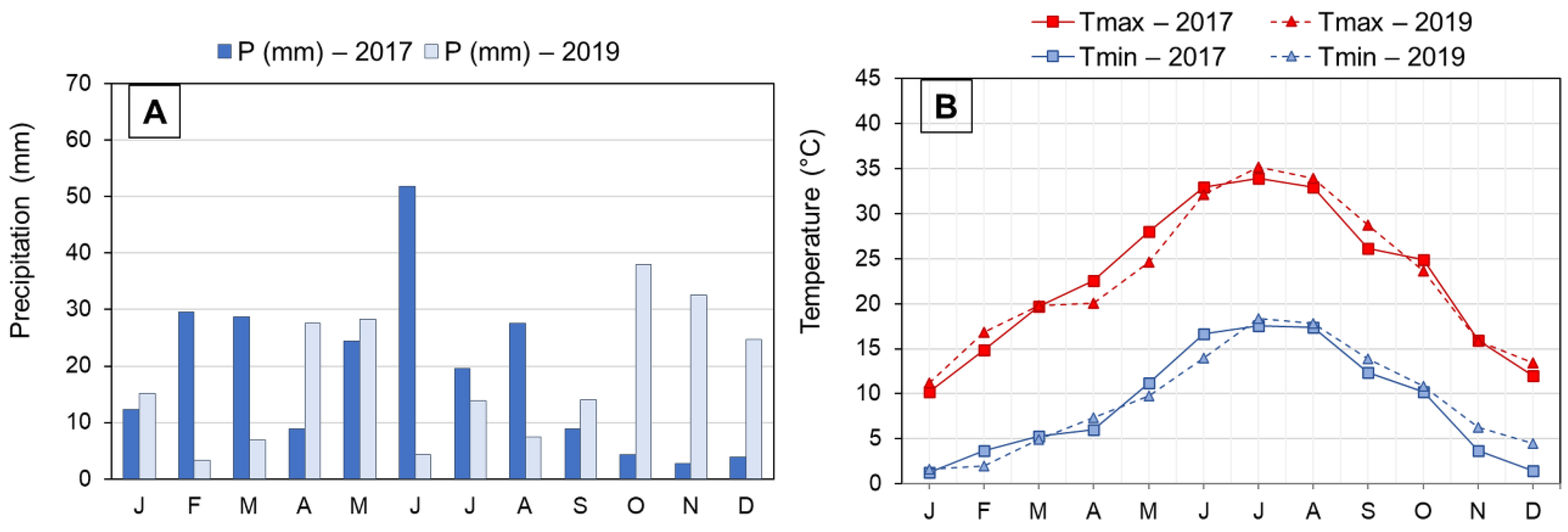
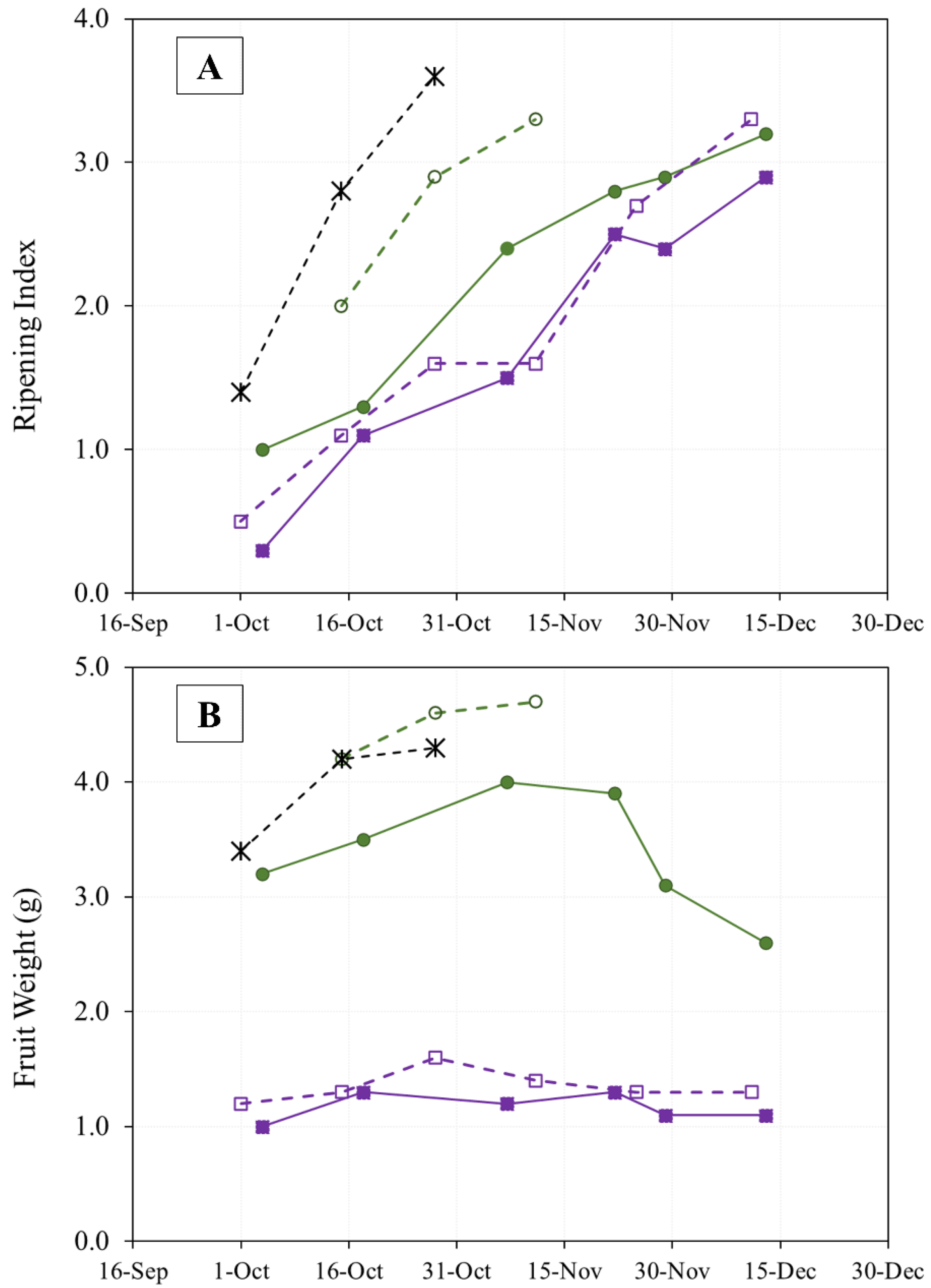
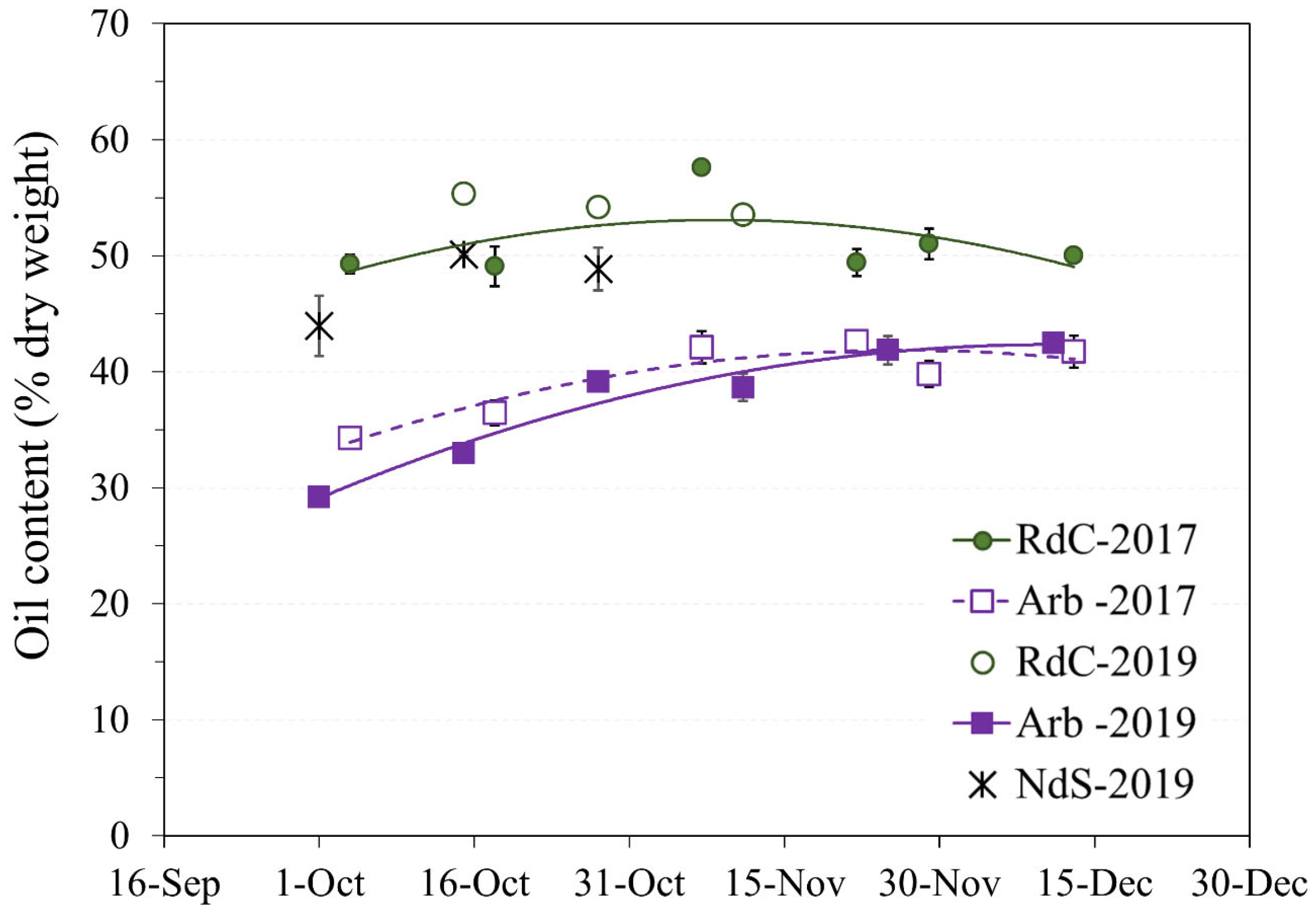
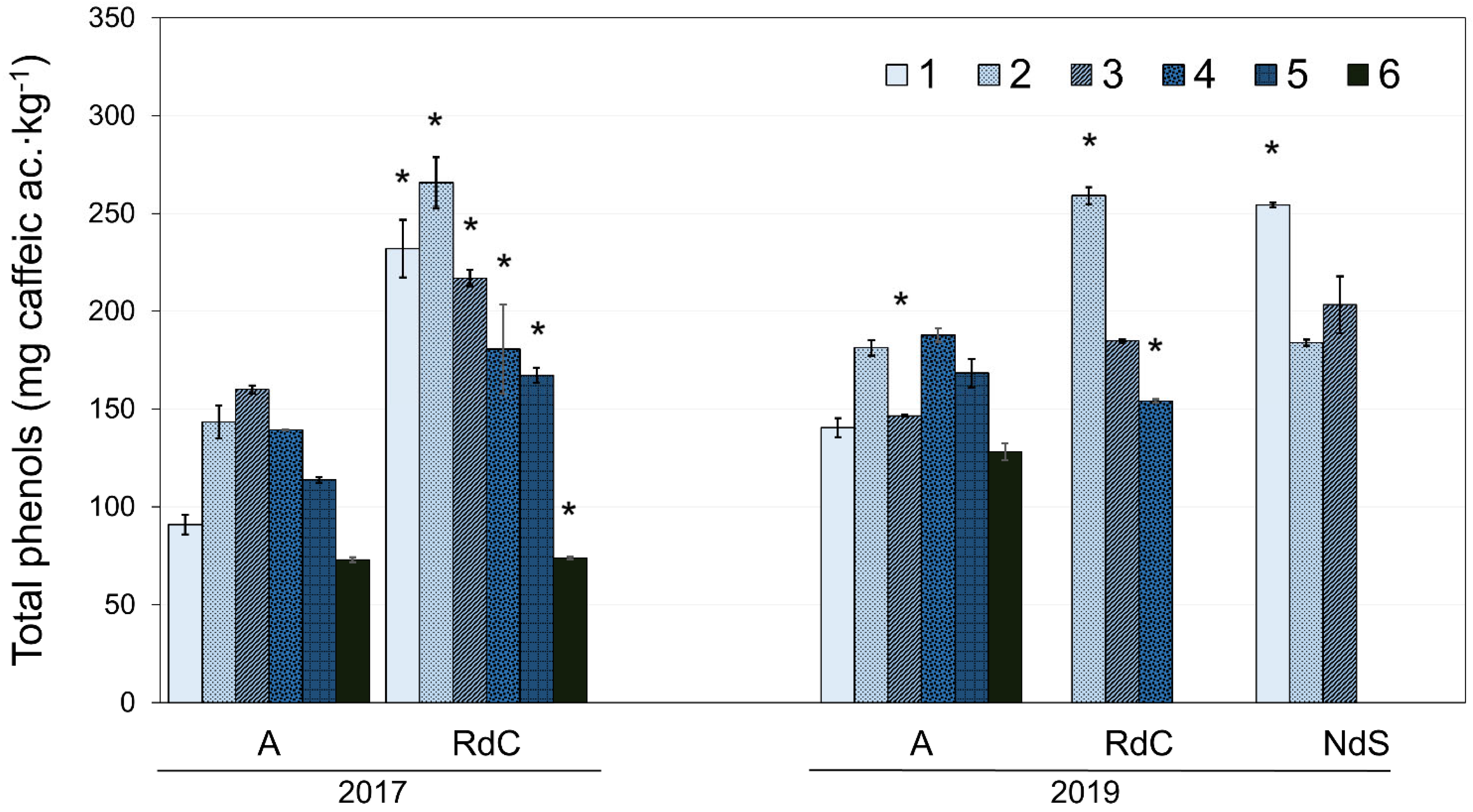
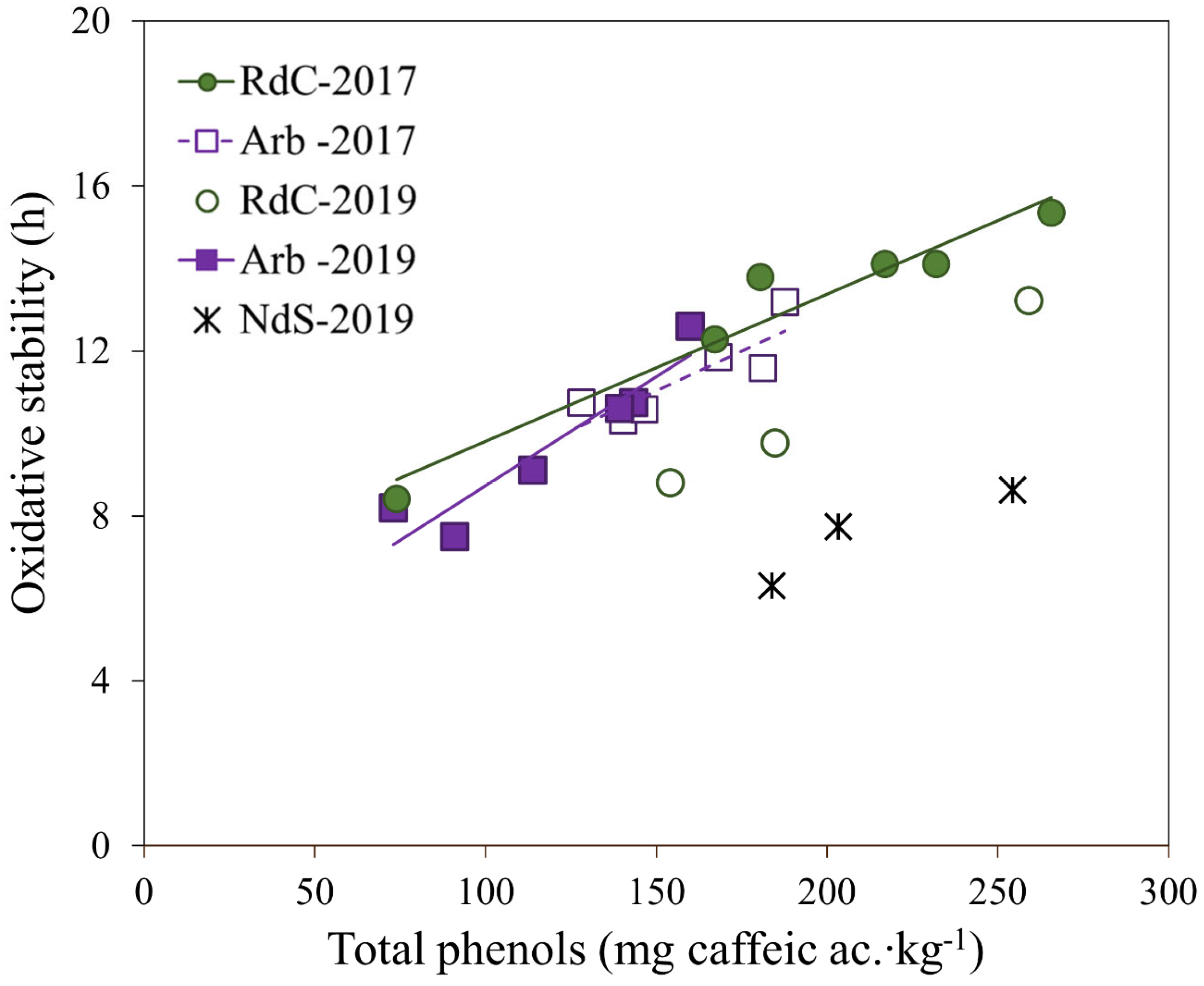
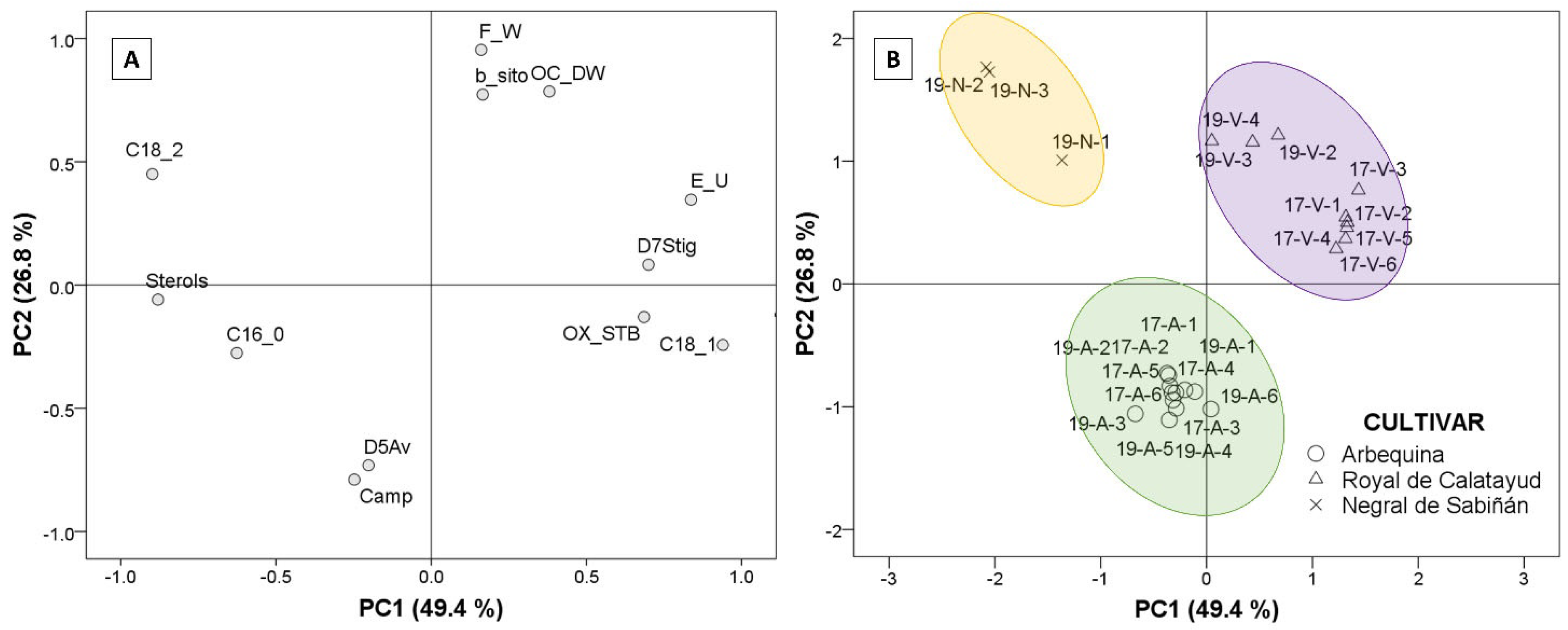

| Cultivar | Harvest Date | FFA (% Oleic Acid) | PV (meq O2∙kg−1) | K270 | K232 |
|---|---|---|---|---|---|
| 2017 | |||||
| Arbequina | 4 October | 0.11 ± 0.00 | 6.54 ± 0.00 | 0.091 ± 0.002 | 1.410 ± 0.004 |
| 18 October | 0.08 ± 0.00 | 4.24 ± 0.19 | 0.078 ± 0.000 | 1.339 ± 0.032 | |
| 7 November | 0.13 ± 0.01 | 2.61 ± 0.18 | 0.082 ± 0.002 | 1.411 ± 0.001 | |
| 22 November | 0.10 ± 0.00 | 3.96 ± 0.15 | 0.079 ± 0.001 | 1.324 ± 0.017 | |
| 29 November | 0.09 ± 0.00 | 4.90 ± 0.14 | 0.082 ± 0.001 | 1.423 ± 0.017 | |
| 13 December | 0.31 ± 0.01 | 5.17 ± 0.22 | 0.072 ± 0.001 | 1.345 ± 0.016 | |
| 2019 | |||||
| 1 October | 0.09 ± 0.00 | 2.36 ± 0.02 | 0.094 ± 0.000 | 1.509 ± 0.000 | |
| 15 October | 0.06 ± 0.00 | 1.62 ± 0.00 | 0.083 ± 0.000 | 1.517 ± 0.013 | |
| 28 October | 0.08 ± 0.00 | 1.40 ± 0.05 | 0.072 ± 0.001 | 1.505 ± 0.002 | |
| 11 November | 0.08 ± 0.00 | 2.69 ± 0.05 | 0.079 ± 0.000 | 1.314 ± 0.004 | |
| 25 November | 0.06 ± 0.00 | 2.15 ± 0.01 | 0.077 ± 0.001 | 1.341 ± 0.005 | |
| 11 December | 0.06 ± 0.00 | 3.62 ± 0.04 | 0.074 ± 0.001 | 1.408 ± 0.006 | |
| 2017 | |||||
| Royal de Calatayud | 4 October | 0.18 ± 0.01 | 5.47 ± 0.02 | 0.089 ± 0.001 | 1.378 ± 0.011 |
| 18 October | 0.25 ± 0.01 | 5.38 ± 0.09 | 0.090 ± 0.001 | 1.416 ± 0.010 | |
| 7 November | 0.24 ± 0.01 | 4.72 ± 0.17 | 0.081 ± 0.000 | 1.343 ± 0.024 | |
| 22 November | 0.23 ± 0.01 | 5.13 ± 0.19 | 0.075 ± 0.001 | 1.272 ± 0.036 | |
| 29 November | 0.25 ± 0.01 | 4.50 ± 0.10 | 0.077 ± 0.001 | 1.463 ± 0.024 | |
| 13 December | 0.10 ± 0.00 | 9.08 ± 0.14 | 0.073 ± 0.001 | 1.435 ± 0.009 | |
| 2019 | |||||
| 15 October | 0.41 ± 0.01 | 6.24 ± 0.81 | 0.106 ± 0.001 | 1.503 ± 0.020 | |
| 28 October | 0.38 ± 0.00 | 9.64 ± 0.04 | 0.092 ± 0.000 | 1.565 ± 0.007 | |
| 11 November | - | 7.67 ± 0.40 | 0.094 ± 0.001 | 1.520 ± 0.010 | |
| 2019 | |||||
| Negral de Sabiñán | 1 October | 0.09 ± 0.00 | 4.11 ± 0.13 | 0.088 ± 0.003 | 1.501 ± 0.041 |
| 15 October | 0.17 ± 0.00 | 2.20 ± 0.02 | 0.083 ± 0.000 | 1.531 ± 0.002 | |
| 28 October | 0.12 ± 0.00 | 1.78 ± 0.08 | 0.082 ± 0.001 | 1.460 ± 0.026 | |
| Cultivar | Harvest Date | C16:0 (%) | C18:0 (%) | C18:1 (%) | C18:2 (%) | C18:3 (%) | SFA (%) | MUFA | PUFA | MUFA/PUFA |
|---|---|---|---|---|---|---|---|---|---|---|
| 2017 | ||||||||||
| Arbequina | 4 October | 14.32 ± 0.07 A;H;X | 1.91 ± 0.01 A;H;X | 71.84 ± 0.10 A;H;X | 8.76 ± 0.06 A;H;X | 0.62 ± 0.01 A;H;X | 16.98 ± 0.09 A;H;X | 73.65 ± 0.13 A;H;X | 9.38 ± 0.07 A;H;X | 7.82 ± 0.04 A;H;X |
| 18 October | 14.88 ± 0.08 B;H;X | 1.87 ± 0.01 B;H;X | 70.97 ± 0.10 B;H;X | 9.07 ± 0.06 B;H;X | 0.57 ± 0.01 B;H;X | 17.48 ± 0.09 B;H;X | 72.87 ± 0.13 B;H;X | 9.64 ± 0.07 B;H;X | 7.53 ± 0.04 B;H;X | |
| 7 November | 14.28 ± 0.07 A;H;X | 1.83 ± 0.01 C;H;X | 71.63 ± 0.10 A;H;X | 9.13 ± 0.06 BC;H;X | 0.53 ± 0.01 C;H;X | 16.80 ± 0.09 A;H;X | 73.53 ± 0.13 A;H;X | 9.66 ± 0.07 BC;H;X | 7.58 ± 0.04 BC;H;X | |
| 22 November | 13.69 ± 0.07 C;H;X | 1.86 ± 0.01 B;H;X | 72.44 ± 0.10 C;H;X | 9.03 ± 0.06 B;H;X | 0.48 ± 0.01 D;H;X | 16.24 ± 0.09 C;H;X | 74.24 ± 0.13 C;H;X | 9.51 ± 0.07 AB;H;X | 7.80 ± 0.04 AC;H;X | |
| 29 November | 13.26 ± 0.07 D;H;X | 1.84 ± 0.0 1 C;H;X | 72.90 ± 0.11 D;H;X | 9.04 ± 0.06 B;H;X | 0.50 ± 0.01 E;H;X | 15.80 ± 0.08 D;H;X | 74.63 ± 0.13 D;H;X | 9.54 ± 0.07 AB;H;X | 8.30 ± 0.04 AC;H;X | |
| 13 December | 12.26 ± 0.06 A;H;X | 1.84 ± 0.01 C;H;X | 73.66 ± 0.11 A;H;X | 9.24 ± 0.06 C;H;X | 0.50 ± 0.01 E;H;X | 14.78 ± 0.08 A;H;X | 75.46 ± 0.13 E;H;X | 9.74 ± 0.07 C;H;X | 7.70 ± 0.04 C;H;X | |
| 2019 | ||||||||||
| 1 October | 14.76 ± 0.10 CA;I;X | 1.87 ± 0.01 A;I;X | 71.63 ± 0.06 A;I;X | 8.50 ± 0.04 A;I;X | 0.69 ± 0.01 A;I;X | 17.40 ± 0.12 A;H;X | 73.40 ± 0.06 A;H;X | 9.19 ± 0.05 A;H;X | 7.99 ± 0.04 A;H;X | |
| 15 October | 15.07 ± 0.01 B;H;X | 1.83 ± 0.00 B;I;X | 70.62 ± 0.01 B;I;X | 9.24 ± 0.01 B;H;X | 0.62 ± 0.00 B;I;X | 17.64 ± 0.00 B;H;X | 72.50 ± 0.01 B;I;X | 9.86 ± 0.01 B;I;X | 7.35 ± 0.01 B;I;X | |
| 28 October | 15.14 ± 0.01 B;I;X | 1.80 ± 0.01 C;I;X | 70.03 ± 0.00 C;I;X | 9.67 ± 0.01 C;I;X | 0.56 ± 0.00 C;I;X | 17.63 ± 0.00 B;I;X | 72.14 ± 0.01 C;I;X | 10.22 ± 0.01 C;I;X | 7.06 ± 0.00 C;I;X | |
| 11 November | 14.20 ± 0.01 C;I;X | 1.81 ± 0.00 D;I:;X | 71.60 ± 0.01 A;I;X | 9.23 ± 0.01 B;I;X | 0.56 ± 0.00 C;I;X | 16.71 ± 0.00 C;I;X | 73.51 ± 0.00 D;I;X | 9.78 ± 0.01 D;I;X | 7.52 ± 0.01 D;I;X | |
| 25 November | 13.76 ± 0.00 D;I | 1.79 ± 0.01 C;I | 71.97 ± 0.01 D;I | 9.37 ± 0.01 D;I | 0.55 ± 0.01 D;I | 16.22 ± 0.00 D;I | 73.89 ± 0.00 E;I | 9.91 ± 0.00 E;I | 7.46 ± 0.00 E;I | |
| 11 December | 12.69 ± 0.01 E;I | 1.79 ± 0.00 C;I | 74.03 ± 0.03 E;I | 8.64 ± 0.01 E;I | 0.52 ± 0.00 E;I | 15.15 ± 0.01 E;I | 75.69 ± 0.02 F;H | 9.16 ± 0.02 A;I | 8.27 ± 0.02 F;I | |
| 2017 | ||||||||||
| Royal de Calatayud | 4 October | 13.35 ± 0.07 A;Y | 1.87 ± 0.01 A;Y | 75.17 ± 0.11 A;Y | 6.62 ± 0.04 A;Y | 0.62 ± 0.01 A;X | 15.97 ± 0.09 A;Y | 76.79 ± 0.13 A;Y | 7.24 ± 0.05 A;Y | 10.57 ± 0.06 A;Y |
| 18 October | 12.79 ± 0.07 B;H;Y | 1.85 ± 0.01 B;H;X | 75.95 ± 0.11 B;H;Y | 6.54 ± 0.04 A;H;Y | 0.59 ± 0.01 B;H;X | 15.36 ± 0.08 B;H;Y | 77.51 ± 0.13 B;H;Y | 7.13 ± 0.05 A;H;Y | 10.83 ± 0.06 B;H;Y | |
| 7 November | 11.95 ± 0.06 C;H;Y | 1.81 ± 0.01 C;H;X | 76.66 ± 0.11 C;H;Y | 6.85 ± 0.05 B;H;Y | 0.57 ± 0.01 C;H;Y | 14.45 ± 0.08 C;H;Y | 78.14 ± 0.13 C;H;Y | 7.42 ± 0.05 B;H;Y | 10.49 ± 0.06 A;H;Y | |
| 22 November | 11.46 ± 0.06 D;H;Y | 1.87 ± 0.01 A;H;X | 77.76 ± 0.11 D;H;Y | 6.22 ± 0.04 C;H;Y | 0.55 ± 0.01 D;H;Y | 14.04 ± 0.08 D;H;Y | 79.19 ± 0.13 D;H;Y | 6.77 ± 0.05 C;H;Y | 11.65 ± 0.06 C;H;Y | |
| 29 November | 11.08 ± 0.06 E;Y | 1.83 ± 0.01 D;X | 77.80 ± 0.11 D;Y | 6.61 ± 0.04 A;Y | 0.56 ± 0.01 D;Y | 13.60 ± 0.07 E;Y | 79.22 ± 0.13 D;Y | 7.17 ± 0.05 A;Y | 11.01 ± 0.06 D;Y | |
| 13 December | 10.87 ± 0.06 F;Y | 1.85 ± 0.01 B;X | 78.27 ± 0.11 E;Y | 6.30 ± 0.04 C;Y | 0.56 ± 0.01 CD;Y | 13.42 ± 0.07 E;Y | 79.69 ± 0.13 E;Y | 6.90 ± 0.05 C;Y | 11.57 ± 0.06 C;Y | |
| 2019 | ||||||||||
| 15 October | 13.83 ± 0.01 A;I;Y | 1.92 ± 0.01 A;I;Y | 72.21 ± 0.01 A;I;Y | 8.84 ± 0.00 A;I;Y | 0.64 ± 0.00 A;I;Y | 16.40 ± 0.02 A;I;Y | 74.11 ± 0.01 A;I;Y | 9.48 ± 0.00 A;I;Y | 7.82 ± 0.00 A;I;Y | |
| 28 October | 13.40 ± 0.02 B;I;Y | 1.94 ± 0.01 B;I;Y | 72.44 ± 0.01 B;I;Y | 9.09 ± 0.02 B;I;Y | 0.64 ± 0.01 A;I;Y | 15.98 ± 0.01 B;I;Y | 74.30 ± 0.01 B;I;Y | 9.72 ± 0.03 B;I;Y | 7.64 ± 0.02 B;I;Y | |
| 11 November | 13.46 ± 0.00 C;I;Y | 2.06 ± 0.00 C;I;Y | 71.52 ± 0.02 C;I;Y | 9.75 ± 0.02 C;I;Y | 0.72 ± 0.00 B;I;Y | 16.23 ± 0.01 C;I;Y | 73.30 ± 0.02 C;I;Y | 10.46 ± 0.02 C;I;Y | 7.01 ± 0.02 C;I;Y | |
| 2019 | ||||||||||
| Negral de Sabiñán | 1 October | 13.63 ± 0.03 A;Y | 1.90 ± 0.00 A;Y | 67.35 ± 0.02 A;Y | 14.41 ± 0.01 A;Y | 0.61 ± 0.00 A;Y | 16.19 ± 0.03 A;Y | 68.79 ± 0.02 A;Y | 15.01 ± 0.01 A;Y | 4.58 ± 0.00 A;Y |
| 15 October | 14.07 ± 0.04 B;Z | 1.84 ± 0.00 B;Z | 63.11 ± 0.01 B;Z | 18.34 ± 0.02 B;Z | 0.59 ± 0.00 B;Z | 16.52 ± 0.04 B;Z | 64.56 ± 0.02 B;Z | 18.92 ± 0.02 B;Z | 3.41 ± 0.00 B;Z | |
| 28 October | 13.92 ± 0.04 C;Z | 1.83 ± 0.00 C;Z | 62.98 ± 0.04 C;Z | 18.63 ± 0.00 C;Z | 0.60 ± 0.00 C;Z | 16.37 ± 0.03 C;Z | 64.41 ± 0.03 C;Z | 19.23 ± 0.00 C;Z | 3.35 ± 0.00 C;Z | |
| Cultivar | Harvest Date | Cholesterol † | Campesterol † | Stigmasterol † | β-Sitosterol | App. β-Sitosterol † | Δ5-Avenasterol | Δ7-Stigmastenol † | Total sterols † | E + U † |
|---|---|---|---|---|---|---|---|---|---|---|
| 2017 | ||||||||||
| Arbequina | 4 October | 0.09 ± 0.01 AB;H;X | 4.29 ± 0.03 A;H;X | 0.89 ± 0.01 AC;H;X | 82.51 ± 0.08 A;H;X | 93.48 ± 0.06 A;H;X | 8.11 ± 0.00 A;H;X | 0.30 ± 0.01 A;H;X | 1702 ± 1 A;H;X | 1.65 ± 0.04 A;H;X |
| 18 October | 0.08 ± 0.01 AC;H;X | 4.06 ± 0.01 B;H;X | 0.86 ± 0.01 A;H;X | 80.96 ± 0.10 B;H;X | 93.79 ± 0.05 BC;H;X | 10.29 ± 0.07 B;H;X | 0.21 ± 0.02 B;H;X | 1489 ± 8 B;H;X | 1.61 ± 0.34 AC;H;X | |
| 7 November | 0.11 ± 0.02 B;H;X | 3.93 ± 0.02 C;H;X | 0.90 ± 0.02 C;H;X | 77.60 ±0.08 C;H;X | 93.70 ± 0.09 B;H;X | 13.78 ± 0.01 C;H;X | 0.17 ± 0.00 CD;H;X | 1536 ± 7 BC;H;X | 1.62 ± 0.21 AC;H;X | |
| 22 November | 0.07 ± 0.00 AC;H;X | 3.71 ± 0.01 D;H;X | 0.90 ± 0.00 C;H;X | 75.35 ±0.17 D;H;X | 93.92 ± 0.06 C;H;X | 15.76 ± 0.12 D;H;X | 0.20 ± 0.01 BC;H;X | 1601 ± 63 C;H;X | 2.06 ± 0.80 B;H;X | |
| 29 November | 0.06 ± 0.00 C;H;X | 3.88 ± 0.01 E;H;X | 0.82 ± 0.01 D;H;X | 77.53 ±0.15 C;H;X | 93.94 ± 0.00 C;H;X | 14.35 ± 0.16 E;H;X | 0.16 ± 0.01 D;H;X | 1693 ± 9 A;H;X | 1.97 ± 0.02 AB;H;X | |
| 13 December | 0.10 ± 0.0 AB;H;X | 3.83 ± 0.01 F;H;X | 0.88 ± 0.02 AC;H;X | 75.99 ± 0.50 E;H;X | 93.87 ± 0.04 C;H;X | 15.67 ± 0.14 D;H;X | 0.17 ± 0.03 CD;H;X | 1682 ± 8 A;H;X | 1.22 ± 0.04 C;H;X | |
| 2019 | ||||||||||
| 1 October | 0.11 ± 0.02 A;H;X | 4.15 ± 0.02 A;I;X | 1.00 ± 0.02 A;I;X | 81.83 ± 0.19 A;I;X | 93.35 ± 0.10 A;H;X | 8.73 ± 0.00 A;I;X | 0.35 ± 0.02 A;I;X | 1407 ± 21 AB;I;X | 1.46 ± 0.10 AB;H;X | |
| 15 October | 0.12 ± 0.04 A;H;X | 3.99 ± 0.02 B;H;X | 0.90 ± 0.02 B;H;X | 79.71 ± 0.42 B;I;X | 93.61 ± 0.16 BD;H;X | 10.75 ± 0.02 B;H;X | 0.23 ± 0.02 B;H;X | 1381 ± 12 A;I;X | 1.66 ± 0.10 BD;H;X | |
| 28 October | 0.11 ± 0.05 A;H;X | 3.65 ± 0.01 C;I;X | 0.83 ± 0.02 CD;H;X | 73.97 ± 0.42 C;I;X | 93.93 ± 0.24 C;H;X | 17.22 ± 0.01 C;I;X | 0.16 ± 0.01 C;H;X | 1436 ± 39 B;H;X | 0.93 ± 0.03 C;I;X | |
| 11 November | 0.12 ± 0.01 A;H;X | 3.88 ± 0.01 D;I;X | 0.85 ± 0.03 CD;H;X | 76.54 ± 0.28 D;H;X | 93.78 ± 0.29 D;H;X | 14.78 ± 0.02 D;H;X | 0.16 ± 0.01 C;H;X | 1415 ± 3 AB;H;X | 1.39 ± 0.03 A;H;X | |
| 25 November | 0.12 ± 0.00 A;I | 3.66 ± 0.01 CE;H | 0.87 ± 0.01 BC;H | 73.31 ± 0.11 CE;I | 93.90 ± 0.13 CD;I | 18.14 ± 0.02 E;I | 0.14 ± 0.01 C;H | 1496 ± 0 C;I | 1.55 ± 0.03 AB;I | |
| 11 December | 0.10 ± 0.01 A;H | 3.70 ± 0.03 E;I | 0.81 ± 0.00 D;I | 74.59 ± 0.42 CF;H | 93.87 ± 0.17 CD;H | 16.88 ± 0.03 C;I | 0.17 ± 0.03 C;H | 1400 ± 2 AB;I | 1.84 ± 0.12 D;I | |
| 2017 | ||||||||||
| Royal de Calatayud | 4 October | 0.16 ± 0.00 AB;Y | 3.70 ± 0.02 A;Y | 1.11 ± 0.01 A;Y | 84.90 ± 0.02 A;Y | 93.37 ± 0.02 A;X | 6.06 ± 0.01 A;Y | 0.36 ± 0.03 A;X | 1011 ± 2 A;Y | 3.81 ± 0.15 AB;Y |
| 18 October | 0.12 ± 0.02 AC;H;X | 3.43 ± 0.01 B;H;Y | 1.25 ± 0.02 B;H;Y | 84.07 ±0.07 B;H;Y | 93.63 ± 0.06 B;H;X | 7.19 ± 0.06 B;H;Y | 0.28 ± 0.00 B;H;X | 1089 ± 22 B;H;Y | 3.41 ± 0.46 AB;H;Y | |
| 7 November | 0.18 ± 0.01 B;H;Y | 3.30 ± 0.02 C;H;Y | 1.35 ± 0.01 C;H;Y | 81.64 ±0.02 C;H;Y | 93.28 ± 0.03 A;H;Y | 9.50 ± 0.01 C;H;Y | 0.30 ± 0.02 B;H;Y | 1007 ± 9 A;H;Y | 3.25 ± 0.03 A;H;Y | |
| 22 November | 0.10 ± 0.02 CE;H;X | 3.36 ± 0.01 D;H;Y | 1.15 ± 0.00 DA;H;Y | 81.99 ± 0.32 C;H;Y | 93.69 ± 0.04 B;H;Y | 9.72 ± 0.17 C;H;Y | 0.22 ± 0.02 C;H;X | 1263 ± 41 C;H;Y | - | |
| 29 November | 0.06 ± 0.02 E;X | 3.42 ± 0.00 BE;Y | 1.17 ± 0.02 DE;Y | 82.63 ± 0.19 D;Y | 93.65 ± 0.01 B;Y | 9.06 ± 0.15 D;Y | 0.26 ± 0.02 BC;Y | 1360 ± 7 D;Y | 3.92 ± 0.23 B;Y | |
| 13 December | 0.14 ± 0.02 ABC;X | 3.40 ± 0.03 DE;Y | 1.10 ± 0.02 A;Y | 82.57 ± 0.09 D;Y | 93.70 ± 0.01 B;X | 9.25 ± 0.01 D;Y | 0.27 ± 0.01 BC;Y | 1284 ± 15 C;Y | 3.91 ± 0.01 B;Y | |
| 2019 | ||||||||||
| 15 October | 0.05 ± 0.02 A;H;X | 3.16 ± 0.02 A;I;Y | 1.34 ± 0.02 A;H;Y | 82.73 ± 0.10 A;I;Y | 93.76 ± 0.08 A;H;X | 8.38 ± 0.13 A;I;Y | 0.26 ± 0.01 A;H;X | 1185 ± 2 A;H;Y | 4.35 ± 0.04 A;H;Y | |
| 28 October | 0.08 ± 0.02 A;I;X | 3.18 ± 0.03 A;I;Y | 1.42 ± 0.09 AB;H;Y | 81.50 ± 0.45 B;H;Y | 93.50 ± 0.22 AB;H;X | 9.45 ± 0.11 B;H;Y | 0.24 ± 0.01 AB;I;Y | 1240 ± 22 A;H;Y | 3.83 ± 0.05 B;I;Y | |
| 11 November | 0.07 ± 0.03 A;H;X | 3.32 ± 0.02 B;H;Y | 1.56 ± 0.04 B;I;Y | 82.20 ± 0.09 AB;H;Y | 93.23 ± 0.00 B;I;Y | 8.72 ± 0.08 A;I;Y | 0.22 ± 0.00 B;H;X | 1359 ± 29 B;H;X | 2.79 ± 0.04 C;Y | |
| 2019 | ||||||||||
| Negral de Sabiñán | 1 October | 0.06 ± 0.01 A;X | 3.59 ± 0.01 A;Y | 0.57 ± 0.01 A;Y | 84.80 ± 0.42 A;Y | 94.60 ± 0.18 A;Y | 7.14 ± 0.19 A;Y | 0.17 ± 0.02 A;Y | 1947 ± 8 A;Y | 0.69 ± 0.14 A;Y |
| 15 October | 0.06 ± 0.01 A;X | 3.37 ± 0.02 B;Z | 0.58 ± 0.01 A;X | 84.25 ± 0.05 A;Z | 95.00 ± 0.10 A;Y | 8.24 ± 0.02 A;Z | 0.12 ± 0.01 A;Z | 1873 ± 19 B;Z | 0.72 ± 0.11 A;X | |
| 28 October | 0.06 ± 0.01 A;X | 3.33 ± 0.02 B;Y | 0.79 ± 0.02 A;X | 83.09 ± 0.22 A;Z | 94.39 ± 0.27 A;Z | 8.56 ± 0.26 A;Z | 0.12 ± 0.05 A;Z | 1851 ± 13 B;Y | 0.80 ± 0.26 A;Z | |
Disclaimer/Publisher’s Note: The statements, opinions and data contained in all publications are solely those of the individual author(s) and contributor(s) and not of MDPI and/or the editor(s). MDPI and/or the editor(s) disclaim responsibility for any injury to people or property resulting from any ideas, methods, instructions or products referred to in the content. |
© 2023 by the authors. Licensee MDPI, Basel, Switzerland. This article is an open access article distributed under the terms and conditions of the Creative Commons Attribution (CC BY) license (https://creativecommons.org/licenses/by/4.0/).
Share and Cite
Rey-Giménez, R.; Vázquez Ayala, S.; Laya Reig, D.; Sánchez-Gimeno, A.C. Chemometric and Physico-Chemical Characterization of Fruit and Olive Oils from Autochthonous Cultivars Grown in Aragon (Spain). Foods 2023, 12, 803. https://doi.org/10.3390/foods12040803
Rey-Giménez R, Vázquez Ayala S, Laya Reig D, Sánchez-Gimeno AC. Chemometric and Physico-Chemical Characterization of Fruit and Olive Oils from Autochthonous Cultivars Grown in Aragon (Spain). Foods. 2023; 12(4):803. https://doi.org/10.3390/foods12040803
Chicago/Turabian StyleRey-Giménez, Raquel, Sergio Vázquez Ayala, Diego Laya Reig, and Ana Cristina Sánchez-Gimeno. 2023. "Chemometric and Physico-Chemical Characterization of Fruit and Olive Oils from Autochthonous Cultivars Grown in Aragon (Spain)" Foods 12, no. 4: 803. https://doi.org/10.3390/foods12040803
APA StyleRey-Giménez, R., Vázquez Ayala, S., Laya Reig, D., & Sánchez-Gimeno, A. C. (2023). Chemometric and Physico-Chemical Characterization of Fruit and Olive Oils from Autochthonous Cultivars Grown in Aragon (Spain). Foods, 12(4), 803. https://doi.org/10.3390/foods12040803






